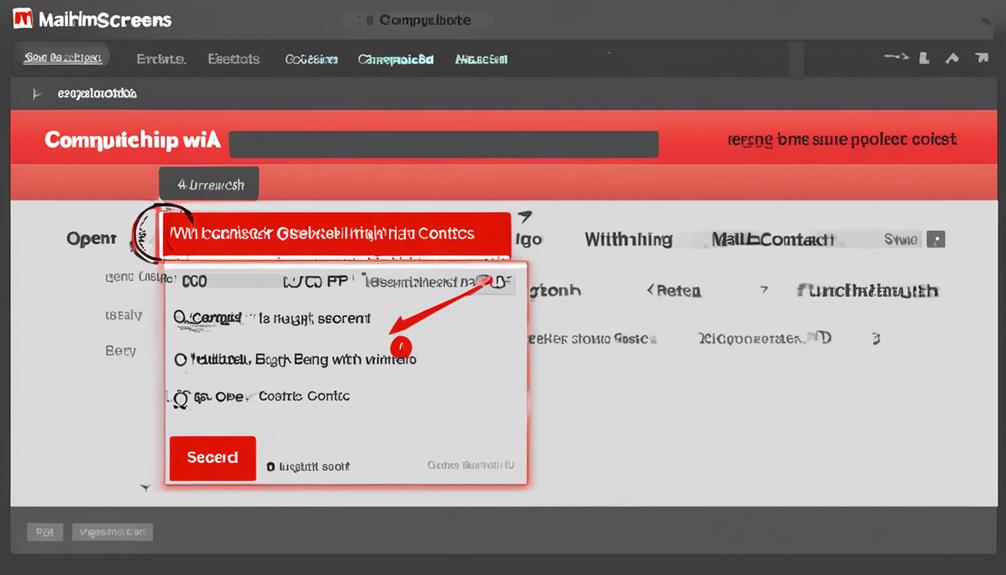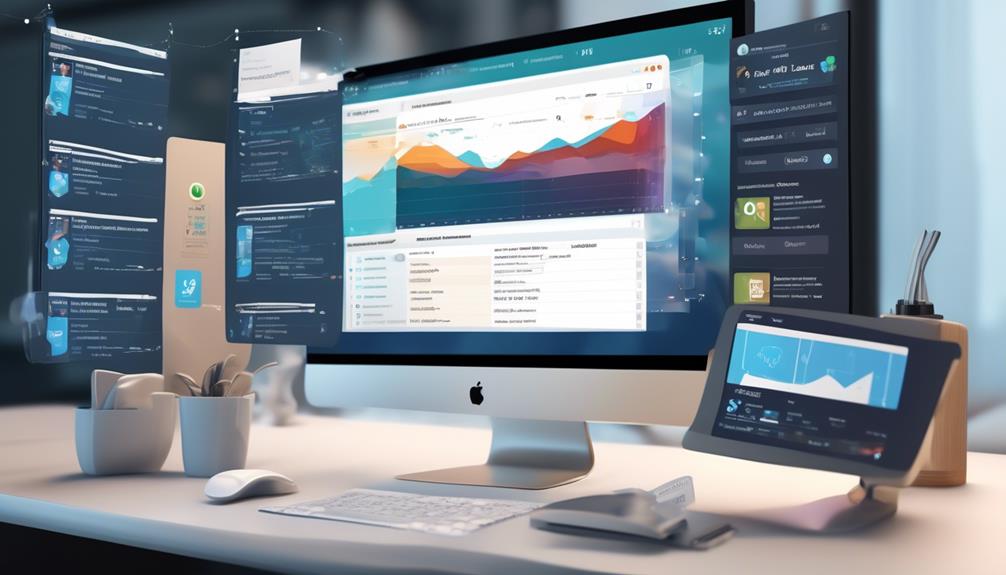When it comes to email marketing automation, many of us are familiar with the saying ‘work smarter, not harder.’ But how can we actually put this into practice? One effective approach is to implement the best strategies for email marketing automation.
From personalized email content to strategic timing and effective audience segmentation, there are numerous tactics that can significantly enhance the impact of your email campaigns. But what are these best practices, and how can they be utilized to drive better results?
Let's explore some key strategies that can elevate your email marketing game and ultimately boost your business's bottom line.
Key Takeaways
- Personalization and segmentation are crucial for effective email marketing automation. Tailor emails based on user behavior and preferences, segment the email list for targeted content, and utilize data-driven insights for effective personalization.
- Timing and metrics play a significant role in email marketing automation. Consider audience time zones and behavior patterns, leverage analytics to identify peak engagement periods, and use real-time triggers for sending emails at opportune moments.
- Subject lines and content optimization are essential for improving open and click-through rates. Craft attention-grabbing subject lines within the ideal character count range, personalize subject lines, and continuously test and refine variations. Additionally, analyze performance metrics to optimize content engagement.
- Email design and mobile optimization are crucial for delivering a seamless user experience. Use responsive design, optimize font sizes and images for easy visibility, and test email layouts across different devices and email clients. Prioritize single-column layouts for optimal mobile user experience.
Implementing Personalized Email Content
To effectively implement personalized email content, we utilize dynamic content to tailor emails based on user behavior and preferences. By segmenting our email list, we ensure that each audience group receives targeted and relevant content, leading to improved engagement rates. Our approach is data-driven, allowing us to gather insights and personalize email content effectively. A/B testing is a crucial part of our strategy, enabling us to optimize personalized email content for better performance based on real-time results and user interactions.
In addition, we leverage personalized recommendations and product suggestions to enhance the overall customer experience and drive conversions. This personalized approach not only increases customer satisfaction but also contributes to the success of our email marketing automation efforts. By delivering content that resonates with individual preferences and actions, we create a more meaningful connection with our audience, ultimately leading to higher satisfaction and improved conversion rates.
Our commitment to personalized email content is a key driver of our email marketing automation success.
Segmenting Your Email List Effectively

Segmenting our email list effectively involves creating targeted segments based on relevant criteria such as demographics, behavior, or purchase history to deliver personalized email content. By utilizing dynamic content, we can tailor messages to different segments of our audience, increasing the relevance and impact of our emails.
Automated email campaigns, customized to specific customer actions or behaviors, lead to higher engagement and conversion rates. To enhance open rates and engagement, we optimize email subject lines, content, and calls-to-action for each segmented group, ensuring that our messages resonate with recipients.
Continuous monitoring and refinement of automated email campaigns through testing and optimization are essential to ensure maximum effectiveness for each segment. By implementing these best practices, we can effectively segment our email list, leading to improved engagement, higher conversion rates, and ultimately, stronger relationships with our audience.
In the realm of email marketing automation, segmenting your email list effectively is a cornerstone for delivering targeted, personalized content that drives results.
Timing Your Automated Emails Strategically
After effectively segmenting our email list to deliver personalized content, we now turn our focus to strategically timing our automated emails for maximum impact.
Timing your automated emails strategically is crucial for optimizing open and click-through rates. It's essential to consider your audience's time zones and behavior patterns when scheduling automated emails. Leveraging analytics to track the best times for sending automated emails is fundamental. By analyzing data, you can identify peak engagement periods and adjust your email schedule accordingly.
Real-time triggers can be incredibly effective in sending automated emails at the most opportune moments, ensuring that your messages reach recipients when they're most likely to engage.
Additionally, testing different timing strategies is key to optimizing the effectiveness of your automated email campaigns. This data-driven approach allows you to refine your timing for maximum impact.
In the realm of email marketing automation best practices, strategic timing holds immense power in driving the success of your campaigns.
Analyzing Email Engagement Metrics

We closely monitor open rates, click-through rates, and conversion rates to gauge email engagement and optimize our email marketing strategy. By analyzing these metrics, we gain valuable insights into subscriber behavior and preferences. Our email service provider offers essential data that allows us to track engagement trends over time, enabling us to refine our email content and delivery for maximum impact.
Utilizing A/B testing is another crucial aspect of analyzing email engagement metrics. This method helps us identify which elements resonate best with our audience, ultimately driving higher engagement. Additionally, segmenting our email lists based on engagement metrics allows us to personalize content, leading to improved results. This targeted approach ensures that our subscribers receive content that aligns with their interests and interactions with our emails.
Optimizing Email Subject Lines
When it comes to optimizing email subject lines, our focus is on subject line length and personalization techniques.
Crafting concise and attention-grabbing subject lines is crucial for boosting open rates.
Subject Line Length
Optimizing email subject lines involves crafting concise and compelling phrases within the ideal character count range of 41 to 50 for maximum engagement. Research shows that subject lines with around 6 to 10 words tend to yield higher open rates. To help you understand the impact of subject line length, here's a comparison of open rates based on different character counts:
| Character Count | Open Rate |
|---|---|
| 1-20 | 18.7% |
| 21-30 | 24.7% |
| 31-40 | 25.2% |
| 41-50 | 26.2% |
Testing subject lines of varying lengths can reveal the optimal character count for your audience. Remember, the key is to keep subject lines relevant and compelling, focusing on clarity and value within the limited character space. Avoid excessively long subject lines that risk truncation and diminishing the impact of your message.
Personalization Techniques
Utilizing personalized elements in email subject lines has been shown to significantly enhance recipient engagement and response rates. When optimizing email subject lines, consider the following personalization techniques:
- Use recipient's names or locations
- Employ A/B testing for optimization
- Incorporate emojis or symbols
- Utilize dynamic content and segmentation
Personalized subject lines can improve open and click-through rates, making it crucial to employ these techniques in email marketing automation best practices.
Creating Automated Email Workflows

When it comes to creating automated email workflows, our focus is on designing effective workflows, crafting personalized content, and tracking performance metrics.
These are key elements for optimizing engagement and conversion rates.
Workflow Design Tips
Based on customer behavior and interactions, plan a clear and logical sequence of automated emails to guide leads through the sales funnel.
When designing email automation workflows for marketing campaigns, consider the following tips:
- Utilize triggers to automate email delivery based on specific actions, such as website visits or form submissions.
- Implement personalized content and timing to maximize engagement and conversions.
- Ensure the workflow is regularly reviewed and optimized to align with marketing goals and customer needs.
- Use a strategic approach to create a seamless and effective journey for leads, from initial interaction to conversion.
Personalized Content Creation
Personalized content creation within automated email workflows allows for the delivery of targeted and relevant messages tailored to individual recipient characteristics, leading to increased engagement and improved conversion rates for email campaigns. By customizing content based on user behavior, preferences, and interactions, businesses can create more impactful email marketing strategies. Implementing personalized content creation in email automation can result in higher open rates and improved campaign performance. To effectively utilize personalized content creation, businesses must consider segmenting their audience and understanding the data to deliver the right message at the right time. This targeted approach can significantly enhance the overall effectiveness of email marketing efforts.
| Benefits of Personalized Content Creation |
|---|
| Increased engagement |
| Higher open rates |
| Improved conversion rates |
| Enhanced user experience |
| Targeted and relevant messaging |
Performance Metrics Tracking
To optimize the effectiveness of personalized content creation within automated email workflows, it's crucial to implement robust performance metrics tracking for measuring the impact and success of these campaigns.
When it comes to performance metrics tracking for email automation, it's essential to monitor open rates, click-through rates, and conversion rates. A/B testing should be utilized to optimize email automation for better engagement and results.
Implementing behavior-based triggers is key to creating targeted and effective automated email campaigns. Additionally, using data and analytics to continuously optimize and improve email automation workflows is paramount for long-term success.
Integrating CRM With Email Automation

When integrating CRM with email automation, it's crucial to ensure seamless integration for efficient lead and customer management. The integration of CRM with email automation streamlines processes and enhances productivity, providing a more efficient and holistic approach to customer relationship management.
Choosing platforms that can easily integrate with your CRM system is essential to avoid additional work and enhance communication. By allocating budget for integrating your email automation and CRM systems, you can simplify lead and customer management processes, ultimately saving time and resources.
This integration also allows for a more targeted and personalized email marketing strategy, ensuring that the right message reaches the right audience at the right time. Moreover, it enables better tracking of customer engagement and interest levels, leading to improved open rates and overall effectiveness of email campaigns.
Therefore, integrating CRM with email automation is a strategic investment in optimizing customer engagement and maximizing the impact of your email marketing efforts.
Compliance With Email Regulations
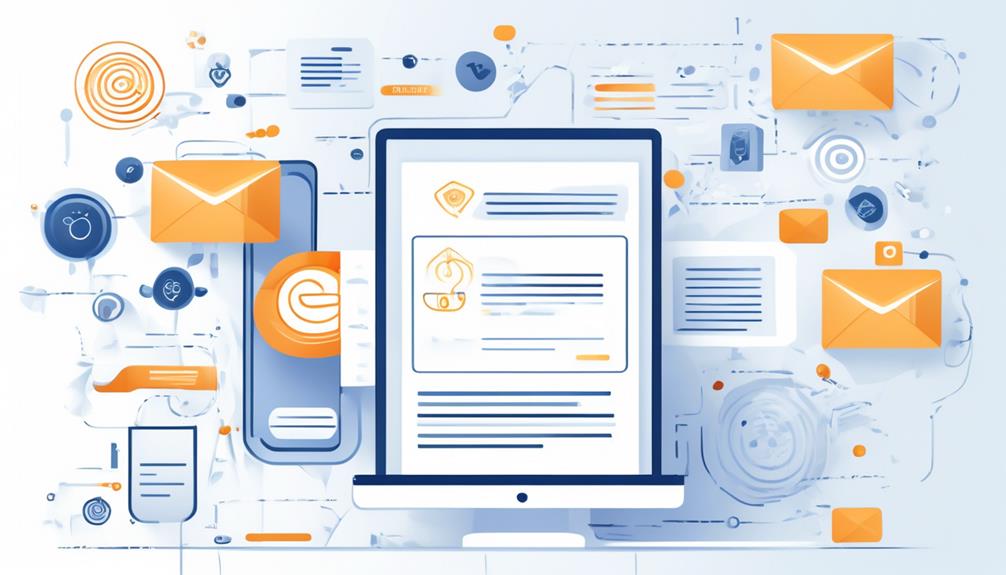
Maintaining compliance with email regulations is essential to avoid legal issues and preserve trust with subscribers. To ensure compliance with email regulations and maintain a positive relationship with subscribers, consider the following best practices:
- Familiarize yourself with the CAN-SPAM Act and GDPR to understand the requirements for sending marketing emails.
- Obtain consent from recipients before sending promotional emails by implementing opt-in processes.
- Provide clear and easy-to-find unsubscribe links in your emails to comply with regulations and respect recipient preferences.
- Regularly update your email lists to remove inactive or unsubscribed contacts to maintain compliance with regulations.
A/B Testing Email Automation Sequences

When A/B testing email automation sequences, we aim to test email subject lines and compare email content to determine the most effective version. This strategic approach allows us to understand the impact of different variables on email engagement, ultimately leading to improved open rates, click-through rates, and conversion rates.
Test Email Subject Lines
A/B testing subject lines in email automation sequences can significantly enhance open rates by 49%, demonstrating the impact of data-driven decision-making on campaign performance. When it comes to email marketing automation, testing subject lines is crucial for optimizing engagement.
Here's how to effectively test email subject lines:
- Utilize A/B testing to compare different subject lines.
- Analyze open rates to determine the most effective subject lines.
- Implement personalization and targeted language in subject lines.
- Continuously iterate and test new subject line variations to improve performance.
Compare Email Content
In optimizing email marketing automation, comparing email content through A/B testing is a fundamental strategy for enhancing engagement and open rates. A/B testing allows for the comparison of different email content variations to determine the most effective messaging. It can be utilized to optimize subject lines, email copy, call-to-action buttons, and visual elements. By analyzing performance metrics such as open rates and click-through rates, A/B testing identifies the most successful email content. Implementing A/B testing in email automation sequences leads to data-driven decision making for content optimization. Below is a table demonstrating how A/B testing can be used to compare different email content variations:
| Element | Variation A | Variation B |
|---|---|---|
| Subject Line | "Limited Time Offer" | "Exclusive Deal Inside" |
| Email Copy | Short and Direct | Detailed and Descriptive |
| Call-to-Action | "Shop Now" | "Discover More" |
| Visual Elements | Single Image | Carousel of Images |
Leveraging Dynamic Content in Emails

Leveraging dynamic content in emails allows for personalized and targeted messaging tailored to each recipient's preferences and behavior. When implementing email automation, utilizing dynamic content can significantly enhance the effectiveness of your campaigns.
Here are some key ways to leverage dynamic content in emails effectively:
- Personalize emails based on recipient's preferences or behavior.
- Tailor email messages for different segments of your audience.
- Customize product recommendations and personalized offers.
- Display different images or text based on recipient's location or past interactions.
Ensuring Mobile-Friendly Email Designs

We understand the importance of ensuring mobile-friendly email designs in reaching a wider audience.
By using responsive design, we can adapt our email layouts to different mobile devices, ensuring optimal viewing experiences.
It's crucial to optimize font sizes, images, and call-to-action buttons for easy visibility and interaction on mobile screens.
Responsive Email Layouts
To ensure optimal readability and user experience on mobile devices, it's crucial to implement responsive email layouts in your email marketing campaigns. Utilize media queries and fluid grid layouts to ensure your email content adjusts to varying screen sizes.
Test your responsive email layouts across different devices and email clients to ensure consistent display. Prioritize the use of single-column layouts in your responsive emails to enhance readability and user experience on mobile devices.
Responsive email layouts adapt to different screen sizes, making your emails easily readable on mobile devices. By incorporating these best practices, your email campaigns will be well-equipped to engage and resonate with audiences across various devices, ultimately maximizing the effectiveness of your email automation efforts.
Optimizing for Small Screens
Optimizing for small screens in email marketing involves ensuring that your responsive layouts effectively adapt to various screen sizes, particularly on mobile devices, to maintain optimal readability and user experience. When optimizing for small screens, it's crucial to employ responsive design techniques that allow email content to adjust seamlessly across different devices. Testing emails on various screen sizes is essential to guarantee compatibility and readability. To cater to mobile users, keep email content concise and visually appealing. Utilize single-column layouts and incorporate large, tappable buttons to enhance ease of use on small screens. Below is a table summarizing key strategies for optimizing email designs for small screens:
| Strategy | Description |
|---|---|
| Responsive Design | Ensure adaptability across various screen sizes, especially on mobile devices. |
| Testing Compatibility | Test emails on different devices and screen sizes to ensure optimal display. |
| Simplified Layout and Design | Keep content concise and visually appealing, utilizing single-column layouts. |
Testing on Mobile Devices
When ensuring mobile-friendly email designs, it's crucial to thoroughly test the responsiveness and usability of email templates across a variety of mobile devices and platforms.
- Test your email designs on various mobile devices and email platforms.
- Check the responsiveness of your email templates by sending test emails to different mobile devices and screen sizes.
- Ensure that your call-to-action buttons and links are easily clickable and visible on mobile devices.
- Test different subject lines and preview text to see how they appear on mobile email clients.
Personalizing Email Sender Details
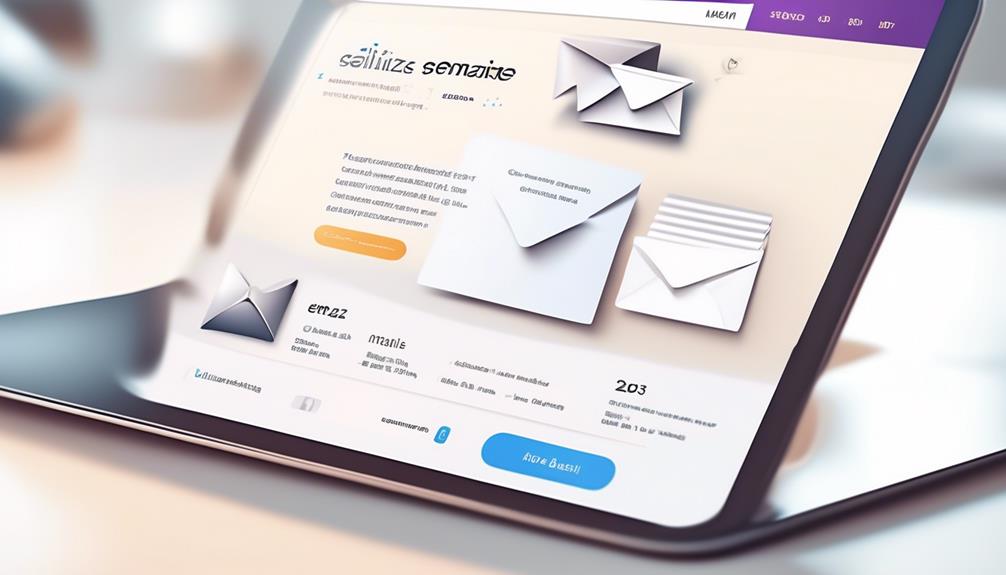
Implement personalized sender names and email addresses to create a more engaging and authentic experience for recipients. Personalizing email sender details is a crucial aspect of an effective email service strategy. By incorporating dynamic sender details, such as customizing sender information based on recipient preferences or demographics, you can enhance the relevance of your emails.
It's also important to align the sender strategy with the recipient's stage in the buyer's journey or their previous interactions with your brand. Leveraging personalization tokens to dynamically populate sender details, like the sender's name and job title, can significantly enhance the credibility and relevance of the email.
Additionally, utilizing A/B testing to optimize the effectiveness of personalized sender details is essential. By testing different sender names or email addresses, you can determine the most impactful approach. This data-driven approach ensures that your personalized sender details resonate with recipients, ultimately leading to improved engagement and conversion rates.
Automating Email List Management

Behavior-based triggers can significantly improve the performance of automated email list management by allowing for more personalized and targeted communication. Here are some best practices for automating email list management:
- Utilize behavior-based triggers to follow up with leads effectively and move them through the sales funnel.
- Implement short-term and long-term nurture sequences to keep leads engaged and interested in your offerings.
- Share diverse forms of content in follow-up emails to provide value and maintain customer interest.
- Incorporate clear call-to-actions in each automated email to inspire immediate action.
Utilizing Email Automation for Lead Nurturing
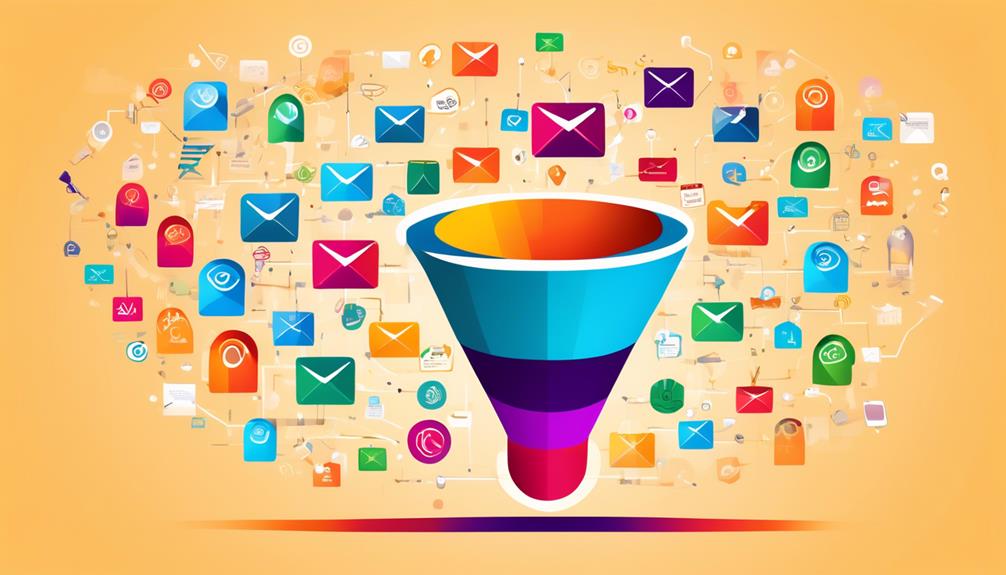
Utilizing email automation for lead nurturing involves organizing emails around clearly defined triggers to effectively guide leads through the nurturing process. By leveraging email automation, businesses can strategically cultivate relationships with potential customers, driving them closer to conversion. Personalized and timely communication is key to nurturing leads, and automation allows for scalability and efficiency in this process. Here's a practical approach to utilizing email automation for lead nurturing:
| Email Automation Strategies | Benefits |
|---|---|
| Use re-engagement emails | Maintain strong customer relationships and keep leads engaged. |
| Prepare emails for common situations | Maximize the benefits of automation by having tailored emails ready for various stages in the customer journey. |
| Personalize emails | Increase customer engagement and enhance the nurturing process by delivering relevant content. |
What are the Best Practices to Follow for Email Marketing Automation as a Beginner?
When diving into beginner email marketing automation, it’s essential to start with personalized, engaging content. Segment your audience to deliver relevant messages. Utilize automation tools to schedule and send emails at the right time. Monitor and analyze performance to optimize your strategy. It’s key to always provide value to your subscribers.
Monitoring and Optimizing Email Deliverability
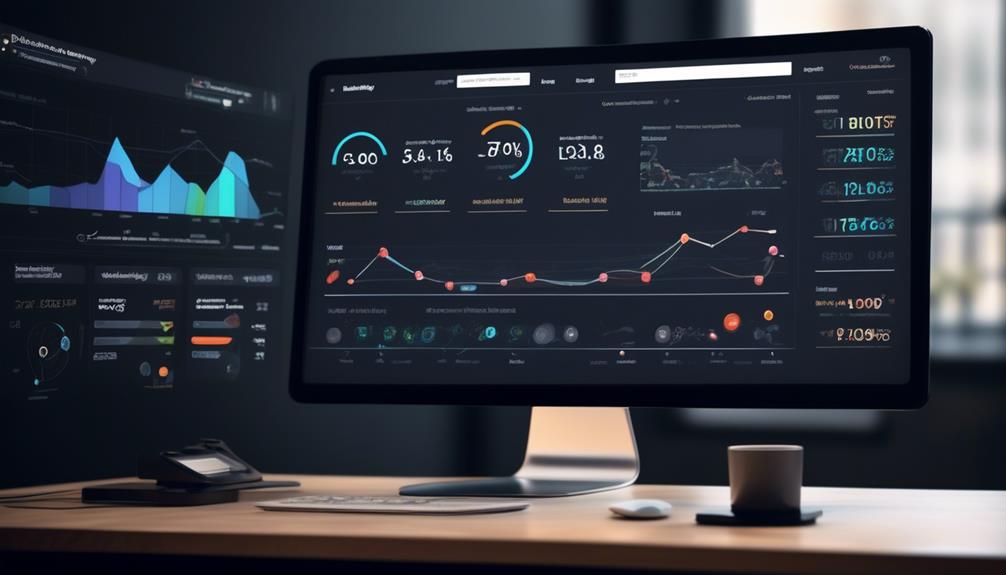
Monitoring and optimizing email deliverability requires constant vigilance and proactive strategies to ensure that emails reach their intended recipients effectively.
To achieve this, we need to regularly monitor email deliverability metrics, such as open rates, click-through rates, and bounce rates, to ensure that emails are reaching the inbox.
Optimizing email content and subject lines is crucial for improving open rates and engagement, so it's essential to test different variations to identify what resonates best with the audience.
Additionally, utilizing segmentation and personalization strategies allows us to tailor emails to specific audience segments, increasing the relevance and effectiveness of our campaigns.
Maintaining a clean email list is also essential, as regularly removing inactive or invalid addresses helps improve deliverability by reducing the risk of being flagged as spam.
Frequently Asked Questions
How Do You Automate Email Marketing?
We automate email marketing by using targeted triggers, personalized content, and A/B testing. This maximizes revenue and increases qualified leads.
Our approach focuses on segmentation and personalization, which significantly improves open rates and engagement. By leveraging data-driven strategies, we optimize our email automation to drive higher click-through and conversion rates.
Our process is strategic and results-oriented, ensuring that our email marketing efforts are effective and impactful.
What Is the Main Goal of Email Marketing Automation?
Our main goal in email marketing automation is to streamline and optimize the process for maximum efficiency and impact.
We aim to deliver personalized and timely communication to engage and nurture leads, ultimately driving conversions and sales.
By automating routine tasks such as welcome emails and follow-ups, we enhance customer experience and improve deliverability.
Measuring success is crucial, involving tracking engagement metrics and analyzing campaign effectiveness to optimize strategies for better results.
What Is the Difference Between Email Marketing and Email Automation?
The difference between email marketing and email automation lies in the manual versus automated process.
With email marketing, each email requires individual scheduling and sending, while email automation streamlines this by setting up triggers to send targeted and personalized emails automatically.
Additionally, email marketing often involves sending the same message to an entire list, whereas email automation allows for segmenting the audience and sending personalized messages based on specific criteria or actions.
Why Is Automation the Smartest Choice for Email Marketing?
We believe automation is the smartest choice for email marketing because it allows us to efficiently deliver personalized and timely messages to our audience.
This approach not only increases engagement but also drives higher conversion rates.
By leveraging data-driven insights and strategically timed campaigns, we can effectively nurture leads and build stronger customer relationships.
Ultimately, automation empowers us to optimize our efforts and achieve a greater return on investment.
Conclusion
In conclusion, by implementing these email marketing automation best practices, we can drive better engagement and results for our campaigns.
Let's continue to analyze and optimize our email content, segment our audience effectively, and utilize automation for lead nurturing.
By doing so, we can build stronger relationships with our audience and ultimately drive business growth.
Remember, success in email marketing automation requires constant testing, optimization, and a commitment to delivering valuable content to our subscribers.



